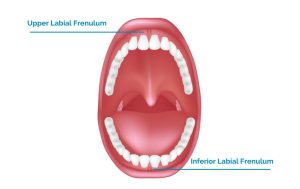FAQ about Labial Frenulum
FAQ
The labial frenum is a mucosal band or fold that connects the lips to the gums.
- In the midline, they are called Medial Frenula or Frenulum.
- Upper Labial Frenulum
- Lower Labial Frenulum
- Lingual Frenulum
- Between the premolars, they are called Lateral Frenula or Frenulum
- Upper Frenula or Frenulum
- Lower Frenula or Frenulum
- Accessory Frenula or Frenulum
- On the tongue (it affects speech and limits tongue movements)

- Frenulum shape
- Frenulum insertion site
- Mucosal (insertion in the mucogingival junction)
- Gingival (insertion in the attached gingiva)
- Papillary (insertion in the interincisal papilla)
- Penetrating Papillary (insertion in the interincisal papilla but penetrates to the palatal papilla. Usually, this is the one that causes diastemas between the central incisors.
- Frenulum composition
- Fibrous (composed of connective tissue and the mucous membrane)
- Muscular (different muscles can be integrated within the frenulum)
- Mixed (a firm tendinous union with the floor of the mouth and, on the other hand, a fibrous cord attached to the alveolar process)
Knowing these things we can make a diagnosis and determine:
- If it is necessary to remove it
- What type of incisions we will make with the laser
- What power we will set the laser to in order to remove it.
The good news is that in many cases we don’t have to remove them.
The medial frenula with mucosal insertion are found in 69% of cases.
The medial frenula with gingival insertion are found in 31% of cases.
Regarding lingual frenula, we should know that they are subdivided into 4 types:
- Frenulum that inserts at the tip of the tongue and causes speech difficulties.
- Frenulum that inserts a few millimeters behind the tip of the tongue, allowing for better movement of the tongue.
- Frenulum that inserts at the base of the tongue (submucosal component).
- No visible lingual frenulum.
Labial frenulum are not considered pathologies of the oral cavity, but those called aberrant frenula do cause changes in the protective periodontium and are considered mucogingival deformities with a great impact on the function and aesthetics of the patient.
Frenula that insert into:
- The papilla
- Those that penetrate the vestibular papillae to the palatal papilla
- The lingual frenula
Are most commonly associated with:
- Gingival recessions
- Loss of papillae
- Accumulation of bacterial plaque by impeding easy cleaning with a toothbrush
- Limitations in the movement of the upper lip.
In the maxillary arch, we can observe patients with short smiles, where the gums are prominently displayed. This may be due to the presence of this type of frenulum and removing it results in a notable improvement in the drooping of the lip without the need for gingival trimming or placement of aesthetic veneers.
They can alter the retention and stability of removable prostheses. Often, the prostheses do not fit well due to the frenula or limit the extension of the prosthesis, altering its retention and stability.
- Aberrant frenula can cause diastemas in the upper incisors. In orthodontic and maxillary orthopedic treatments, we often encounter diastemas caused by the insertion of these frenula, which in many cases have an insertion in the palate and, if not removed, make orthodontic treatment ineffective.
Hypertrophic upper labial frenula can cause a larger than usual space between the central incisors, giving rise to what is known as an interincisal diastema.
Many dental professionals (general dentists, orthodontists) do not perform these frenectomies and refer them to periodontists who use diode or Erbium LASER technology, as the results are simply magnificent; with this technology, less anesthesia is involved, recovery is faster, and procedures are less invasive. The diode laser causes less tissue damage, less bleeding, and does not require sutures. In general, the patient’s body responds better to minimally invasive LASER dentistry than to traditional procedures (anesthesia, incisions, and sutures).



